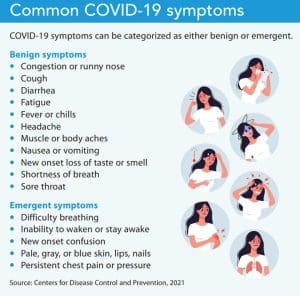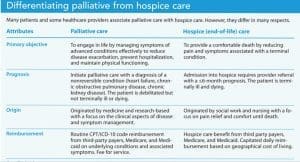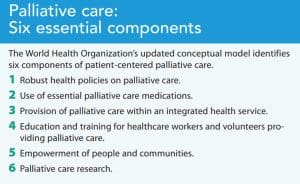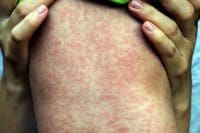Primary care symptom management can enhance quality of life and prevent hospitalization.
Takeaways:
- Early identification and reporting of symptomatic COVID-19 patients in the primary care setting can improve outcomes.
- Initiating prompt symptom management or palliative interventions can reduce symptom exacerbation, hospitalization, and debility.
- Nurses should prepare for a global paradigm shift of palliative care into primary care settings.
Since the beginning of the COVID-19 pandemic, more than 84 million Americans have been infected and over 1 million have died. According to the Centers for Disease Control and Prevention (CDC) National Vital Statistics System, which provides daily and weekly COVID-19 mortality updates extracted from state-reported death certificates, almost 68% of deaths occurred in a hospital and about 14% in a nursing home or long-term care facility. From January 2020 through December 2021, mortality rates from COVID-19 occurred primarily in patients 85 years and older with multiple comorbidities.
Many patients with COVID-19 experience several symptoms that require skilled nursing observation, recognition, and management. Most of these patients aren’t terminally ill or dying, but their comfort and quality of life require symptom and morbidity management during and after the infection. As integral members of healthcare teams in primary and home care settings, nurses play a vital role in assessing and evaluating patients for early symptom onset before an exacerbation and for worsening symptoms that can lead to hospitalization, debility, and possible death. (See Common COVID-19 symptoms.)

COVID-19 offers a model for implementing palliative care in patients who aren’t at the end-of-life or who have a limited prognosis of 6 months or less. Many patients and healthcare professionals associate palliative care with end-of-life, hospice, or terminal care. Understanding COVID-19 symptoms and reviewing the origins and current trends of palliative care enable nurses to best meet the comprehensive needs of these patients.
COVID-19 symptom research
Two years into the pandemic, we’re still experiencing a steep learning curve and an urgency to generate credible evidence for COVID-19 symptom management. A study by Moriyama and colleagues, which identified mortality demographics during the initial surge of COVID-19, found that, compared to before the pandemic, inpatient palliative care services experienced an increase in patients who were healthy at baseline and acutely ill at admission.
A large observational study of 20,133 hospitalized patients in the United Kingdom reported that symptoms escalated rapidly in patients with severe COVID-19. The researchers noted that the most common symptoms included cough, fever, breathlessness, and fatigue. Patients who remained hospitalized had higher morbidity and mortality rates due to multiple comorbidities (cardiac disease, diabetes, chronic obstructive pulmonary disease, chronic kidney disease).
A systematic review of the literature showed that descendants and patients reported several common symptoms, including breathlessness, coughing, diarrhea, and fatigue. Case studies of 101 patients with severe COVID-19, who were referred to three palliative care teams in London, cited breathlessness, agitation, drowsiness, and delirium as predominant symptoms. These data correlate with the CDC’s reported symptoms.
The authors of a systematic review of pharmacologic and nonpharmacologic symptom management in patients diagnosed with COVID-19 suggest that more studies are needed to better understand the effectiveness of palliative interventions to manage specific COVID-19 symptoms.
Palliative care defined
Palliative care, a term first coined by Mount in 1974, focuses on quality of life via optimal symptom management. Evidence collected by providers, researchers, and advocates over the intervening decades has differentiated palliative care from end-of-life care. This evidence also indicates that early implementation of palliative care enhances optimal patient-centered outcomes. (See Differentiating palliative from hospice care.)


According to the World Health Organization (WHO), palliative care is most effective when implemented early in the course of illness. It helps prevent symptom exacerbation, reduce hospitalization, and maintain physical functioning. In most countries, palliative care is delivered through primary health, community, and home-based care. Many countries that follow WHO directives have established national policies to ensure access to quality palliative care.
In December 2021, WHO released a global consensus document with an updated conceptual model that identifies six essential components required to optimize palliative care with an integrated patient-centered approach. The recent American Academy of Nursing Expert Panel consensus statement on nursing’s role in ensuring universal palliative care includes many of these components. (See Palliative care: Six essential components.)

The model emphasizes access and implementation across the continuum of healthcare. It also shows a limited need for specialty palliative care providers when offering comprehensive symptom management. According to WHO, moving palliative care into the coordinated and comprehensive primary care setting provides patients and families with protective, preventive, curative, and rehabilitative care.
U.S. palliative care recommendations
The U.S. Department of Health and Human Services sponsored the National Academies of Science, Engineering, and Medicine as host of a one-day workshop to explore primary care providers’ ability to implement palliative care in patients with advanced or serious conditions. Proceedings from that workshop highlight the findings and expert recommendations, which include implementing palliative care at the time of diagnosis in patients with chronic symptomatic conditions.
Early palliative care in the primary care setting reduces hospitalizations, provides comprehensive and coordinated care, and reduces costs. Additional findings suggest that not enough specialized or certified palliative care providers will be available to meet the escalating demands of the nation’s aging population.
Applying palliative care to COVID-19
COVID-19 presents a global clinical challenge at all levels of the healthcare system. Most patients are symptomatic but not dying or terminally ill. Nurses with sound clinical assessment skills and knowledge of common COVID-19 signs and symptoms can promote early integration of palliative management (for example, bronchodilators, rest, hydration, nutrition, acetaminophen, and nonsteroidal anti-inflammatory drugs) to reduce symptom burden, prevent exacerbation of underlying conditions, avoid hospitalization, and maintain physical functioning and quality of life. Astute assessment is especially important for patients with chronic conditions who are diagnosed with COVID-19.
Nurses can access credible evidence established by several global and federal agencies, medical groups, researchers, and scientists to guide clinical decision making that optimizes COVID-19 symptom management. (See Reliable sources of evidence.)
Several current evidence-based resources can help support clinical management of patients with symptomatic COVID-19. COVID-19 continues to challenge healthcare systems, providers, researchers, and policy makers. As a global community of shared evidence, we must accept the inevitable changes resulting from the pandemic. Moving palliative care into the primary care setting can help nurses ensure timely, comprehensive, integrated symptom management for patients with acute or long COVID-19. Kim Kuebler is the director and founder of Multiple Chronic Conditions Resource Center in Darien, Georgia. Andreas M, Piechotta V, Skoetz N, et al. Interventions for palliative symptom control in COVID-19 patients. Cochrane Database Syst Rev. 2021;8(8):CD015061. doi:10.1002/14651858.CD015061 Atkinson Smith M, Peters Kroll N. Patient-centered outcomes of care. In: Kuebler K, ed Integration of Palliative Care in Chronic Conditions: An Interdisciplinary Approach. Pittsburgh, PA: Oncology Nursing Society; 2017. Centers for Disease Control and Prevention. COVID-19 death data and resources. September 14, 2021. cdc.gov/nchs/nvss/covid-19.htm Centers for Disease Control and Prevention. Symptoms of COVID-19. March 2, 2022. cdc.gov/coronavirus/2019-ncov/symptoms-testing/symptoms.html Fair Health. A detailed study of patients with long-haul COVID: An analysis of private healthcare claims. June 15, 2021. Hospice News. Average hospice length of stay on the rise. November 25, 2019. hospicenews.com/2019/11/25/average-hospice-length-of-stay-rose-during-2018 Johns Hopkins University & Medicine. Coronavirus resource center. 2022. coronavirus.jhu.edu Kuebler K. Care of multiple chronic conditions. In: Kuebler K, ed Integration of Palliative Care in Chronic Conditions: An Interdisciplinary Approach. Pittsburgh, PA: Oncology Nursing Society; 2017. Kuebler K, Acker K, Froelich S. Overview palliative care. In: Kuebler K, ed Integration of Palliative Care in Chronic Conditions: An Interdisciplinary Approach. Pittsburgh, PA: Oncology Nursing Society; 2017. Lonas L. At least 20 percent of Americans have been infected with COVID-19, data show. The Hill. January 18, 2022. thehill.com/policy/healthcare/590154-at-least-20-percent-of-americans-have-been-infected-with-covid-19-data-show Lovell N, Maddocks M, Etkind SN. et al. Characteristics, symptom management, and outcomes of 101 patients with COVID-19 referred for hospital palliative care. J Pain Symptom Manage. 2020;60(1):e77-81. doi:10.1016/j.jpainsymman.2020.04.015 Mayo Clinic. Coronavirus disease 2019 (COVID-19). mayoclinic.org/diseases-conditions/coronavirus/symptoms-causes/syc-20479963 Moriyama D, Scherer JS, Sullivan R, Lowy J, Berger JT. The impact of COVID-19 surge on clinical palliative care: A descriptive study from a New York hospital system. J Pain Symptom Manage. 2021;61(3):e1-5. doi:10.1016/j.jpainsymman.2020.12.011 Multiple Chronic Conditions Resource Center. Palliative care. National Academies of Sciences, Engineering and Medicine. Integrating Serious Illness into Primary Care Delivery: Proceedings of a Workshop. Washington, DC: National Academies Press; 2022. doi:10.17226/26411 Palliative Care McGill. History. mcgill.ca/palliativecare/about-us/history Robbins RA, Klotz SA. Brief review of coronavirus for healthcare professionals. Southwest J Pulmonary Crit Care. 2020;20(2):69-70. doi:10.13175/swjpcc011-20 Rosa WE, Buck HG, Squires AP, et al. American Academy of Nursing Expert Panel consensus statement on nursing’s roles in ensuring universal palliative care access. Nur Outlook. 2021;69(6):961-8. doi:10.1016/j.outlook.2021.06.011 Syed A. Coronavirus: A mini-review. Int J Curr Res Med Sci. 2020;6(1):8-10. doi:10.22192/ijcrms.2020.06.01.002 US Department of Health and Humans Services. COVID-19 reported patient impact and hospital capacity by facility. March 31, 2022. World Health Organization. Palliative care. World Health Organization. Assessing the development of palliative care worldwide: A set of actionable indicators. September 29, 2021. who.int/publications/i/item/9789240033351 World Health Organization. Implementing World Health Assembly resolution on palliative care. October 12, 2021. who.int/news/item/12-10-2021-implementing-world-health-assembly-resolution-on-palliative-care World Health Organization. Integrating palliative care and symptom relief into primary health care. October 16, 2018. who.int/publications/i/item/integrating-palliative-care-and-symptom-relief-into-primary-health-care World Health Organization. Quality health services and palliative are: Practical approaches and resources to support policy, strategy and practice. October 4, 2021. who.int/publications/i/item/9789240035164 World Health Organization. WHO takes steps to address glaring shortage of quality palliative care services. October 5, 2021. who.int/news/item/05-10-2021-who-takes-steps-to-address-glaring-shortage-of-quality-palliative-care-services Key words: COVID-19, symptom management, palliative care, primary careReliable sources of evidence
A global approach
References:



















1 Comment. Leave new
Thank you so much